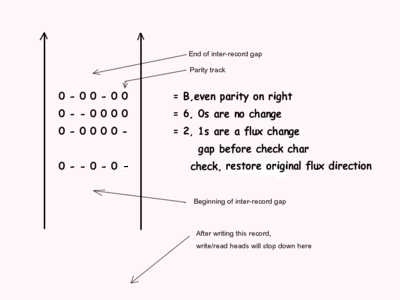Magnetic Tape, Physical Magnetic Data Format
Started - April 10, 2006
We have been waving hands and smiling about the ultimate goal of 'magnetic' tape, the pattern of the physical 'bits' on the tape which are written under control of a computer, and later read as data or indications by a computer.
Time to get into the meat of the matter - assuring that the magnetic changes are correctly written onto the tape.
The magnetic changes of state of a recorded digital tape can "developed" similar to photographic film by dusting the tape with magnetic powder (or in the real world - dipping a section of tape into a low viscosity fluid containing magnetic powder). The resulting pattern of magnetic changes may be seen by humans as dense collections of magnetic powder:-)) This visualization can help assure that everything is OK - and is interesting and re-assuring.
First lets make a symbolic picture of the magnetic situation on a properly recorded piece of tape
- IBM compatible - the "industry standard" in the early 1960s
- 7 track, 6 data tracks, one parity track
- BCD - means among other things that a value of zero is encoded as some bits, as in a 1401
- even character parity - BCD format is recorded with even character parity
- - tape written by other systems in "binary format" were usually odd character parity
- NonReturn to Zero - NRZ - when the tape was moving, the write heads magnetized when writing
- - a data one bit flipped the direction of magnetization
- at the end of the 'data record', one character position was bypassed,
- - and then the write head magnetization was returned to original orientation,
- - effectively giving an even track parity character.
- The tape continued to move almost a half inch, into the forming 3/4 inch "inter-record" gap
- - the tape comes to a stop and the current to the write heads turned off.
We are not getting into other features such as
Got that? Maybe a picture will help. Looking at the magnetic oxide side of the tape:

Now - how are we going to make/buy some "developing solution"? Assuming this magnetic tape visualization is a lost art, and the solutions are not even available on e-bay? ???
In the goode olde daze we could have captured some iron filings from a grind wheel and put them into some carbon tet cleaning solution. Now what solution can we use? ( I should have been dead of a miserable death long ago!! Too bad to die - only the good die young? ) Is there a source of finely divided iron? Would 50 mesh work? http://www.scientificsonline.com/Product.asp_Q_pn_E_3060176 , http://www.sciencekit.com/category.asp_Q_c_E_756151 ,
Here is a solution to the population problem - and also get a Darwinian Award - spray the results of a
spinning grind wheel working on steel into an open pail of gasoline. :-)) Results guaranteed :-))
Allen Palmer responded to the above - politely, thank you
|
Ed.
* NonReturn to Zero - NRZ - when the tape was moving, the write heads magnetized when writing comment.
|
Grant Saviers responded to the above - politely ;-))
|
There was another gadget that was easier to use made by 3M. The
magnetic particles were in a low viscosity fluid sandwiched between a
thin piece of non magnetic stainless (like 0.001" thick or less) and a
piece of glass. One would rub the SS "genie like" and this would
suspend the particles. The image was developed by placing the SS
against the tape.
Both techniques worked well enough that individual bits could be read at 200bpi. At 556bpi, it is a struggle and forget it at 800bpi. b.t.w. when I operated a 1401 in 1966 we always used 556 as 800 wasn't adequately reliable with the tapes of the era in a production environment. The advantage of the solvent process was that an entire record and interblock gaps can be seen (even if the individual bits can't be read) and measured. The "write wide-read narrow" was/is a very desireable feature in tape systems as it liberalizes a number of tolerances in head making and dynamic tape tracking in the tape path. The separate erase head benefits have been often debated - they "clean up" the tape but aren't needed to overwrite previously recorded data (in digital systems). Many excellent tape drives were built without an erase head. While IBM made NRZI the industry standard for a while, it was clearly inferior to PE (phase encoded or Manchester) systems of the day. The first computer tape drive was on the Univac I and it was PE as were subsequent Univac drives, until they were forced to be IBM compatible. Things came full circle when IBM switched to PE with 1600 bpi and then other phase modulation systems in later drives. Even though IBM was on the wrong technology track for a while, they did a superior job of making reliable NRZI systems. I've come to appreciate this in learning how the 1401 data detection circuits work. Grant
One other comment on the iron powder: I think the mesh will need to be more on the order of 500 to 1000 or particles on the order of low 10's of microns (1 micron = 40 u"). Grinding doesn't make particles this small, frequently they are made by volatizing the metal in a flame and condensing out the particles. Welding fumes do get this small which is why special respirators are used. Ball milling can also make them from friable materials, e.g. ferrites. Grant Ed comments - yes - the particles seemed to gather into fine fuzz. You could easily see the clumps of fuzz at 200 characters to the inch. They must have been "very fine". |
Comments to Ed Thelen ed@ed-thelen.org or Allen Palmer or Grant Saviers or ...
return to main page